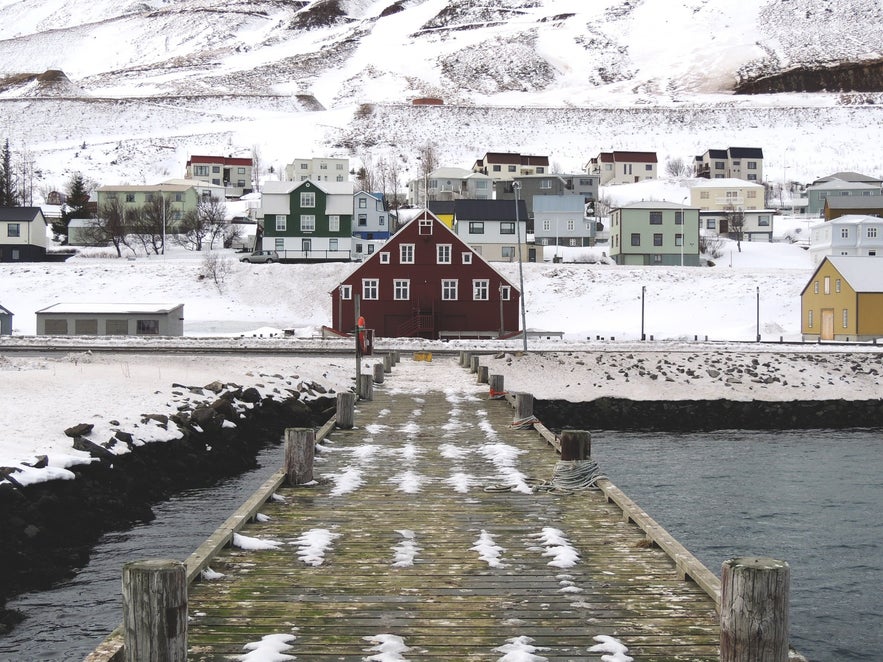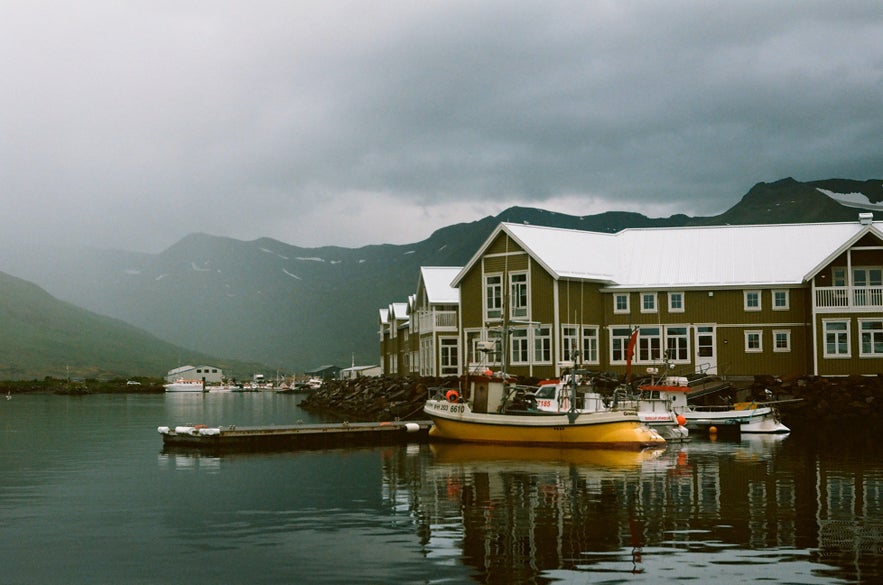
Siglufjördur ist eine Stadt mit etwa 1.300 Einwohnern im Norden Islands. Sie ist die nördlichste Stadt des Festlands.
Am besten erkundest du Siglufjördur auf einer entspannten Mietwagenrundreise. Besonders empfehlenswert ist diese 7-tägige Arctic-Coast-Way-Selbstfahrer-Tour, die in den Sommermonaten angeboten wird.
Warum du unseren Inhalten vertrauen kannst
Guide to Iceland ist die vertrauenswürdigste Reiseplattform Islands und hilft jedes Jahr Millionen von Besuchern. Alle Inhalte werden von lokalen Experten erstellt und geprüft, die Island in- und auswendig kennen. So kannst du dich auf zuverlässige, aktuelle und präzise Reisetipps verlassen.
Neben ihrer natürlichen Schönheit ist die Stadt ein kulturelles Zentrum mit dem preisgekrönten Heringsmuseum, dem Volksmusikmuseum und dem Volksmusikfestival, das jedes Jahr immer mehr Besucher anzieht. Der charmante Ort lädt zum Erkunden ein – wenn du also einen Aufenthalt planst, solltest du unbedingt eine Unterkunft in Siglufjördur buchen.
Foto von Luciano Braga
Wirtschaft
Siglufjördur verfügt über einen der besten Häfen Islands, und die Fischerei war lange Zeit das wirtschaftliche Rückgrat der Stadt. Wie überall in Island sind in den letzten Jahren Dienstleistungen und Tourismus immer wichtiger geworden.
Seit der Eröffnung der Tunnel durch den Fjord Hedinsfjördur im Jahr 2010 ist die Stadt für Reisende auf der Ringstraße oder für Besucher der nördlichen Stadt Akureyri viel leichter erreichbar. Dadurch ist die Zahl der Besucher in den letzten zehn Jahren stark gestiegen.
Geschichte & Kultur
 Foto von Alena Timofeeva
Foto von Alena Timofeeva
Siglufjördur blickt auf eine bewegte Geschichte zurück. Im frühen 20. Jahrhundert entwickelte sich das einstige kleine Dorf rasant und wurde 1918 zur Stadt. Mitte des 20. Jahrhunderts war Siglufjördur eine der größten Siedlungen Islands.
In dieser Zeit war Siglufjördur die Hauptstadt des Heringsfangs im Nordatlantik, und das Heringsmuseum der Stadt zeugt stolz von dieser Geschichte. Hier erfährst du alles über die Bedeutung des Meeres für das Überleben der Isländer – von der Zeit der Besiedlung bis zur Moderne.
Das Heringsmuseum ist eines der größten Schifffahrts- und Industriemuseen Islands. Es ist auf drei Gebäude verteilt: In einem erfährst du alles über den Fischfang und die landesweiten Verarbeitungsprozesse. In einem anderen kannst du zahlreiche Schiffe und Boote aus den 1950er Jahren bestaunen. Die Salzanlage hat ihr ursprüngliches Aussehen bewahrt, und an schönen Sommertagen kannst du den Salzungsprozess live miterleben.
In der alten Grana-Fabrik wird gezeigt, wie aus Heringen Fischmehl und Öl gewonnen wurden.
Das Volksmusikzentrum ist ein weiteres kulturelles Highlight und befindet sich im ehemaligen Wohnhaus des Pfarrers Bjarni Þorsteinsson, dem „Vater von Siglufjördur“. Hier werden alte Volkslieder lebendig: Du kannst Aufnahmen von Menschen hören, die Quintgesänge (tvisöngur) singen, epische Reimgesänge (rímur) vortragen, das Langspil spielen oder alte isländische Kinderlieder singen.
Das Zentrum zeigt auch das Leben von Pfarrer Bjarni.
Das Volksmusikfestival
Anfang Juli findet in Siglufjördur das jährliche Volksmusikfestival statt. Es präsentiert Volksmusik aus verschiedenen Ländern, legt aber einen besonderen Schwerpunkt auf isländische Volksmusik. Es gibt zahlreiche Veranstaltungen, darunter Vorträge und Workshops zu Musik und Handwerk sowie Tanzabende, Konzerte und Feste.
Natur
Siglufjördur liegt in einem besonders schönen, gleichnamigen Fjord, umgeben von hohen, dramatischen Bergen. Die Vogelwelt ist vielfältig: Im Sommer leben rund 2.000 Vögel aus 16 bis 18 Arten im Fjord.
Beliebte Wanderwege sind die Pässe Holsskard und Hestskard, die zum wunderschönen Fjord Hedinsfjördur führen. Dieser ist auch per Boot oder Auto erreichbar.
Der unbewohnte Hedinsfjördur ist von steilen, beeindruckenden Bergen umgeben und bietet ein schönes Tal mit guten Forellengewässern im Hedinsfjardarvatn-See.
Der letzte Bauernhof im Hedinsfjördur wurde 1951 aufgegeben. Im 20. Jahrhundert gab es dort in der Regel fünf bewohnte Höfe, denn die Vegetation ist reich und Nahrung konnte sowohl vom Land als auch aus dem Meer gewonnen werden. Die Winter waren jedoch hart, es gab viele Lawinen und der Fjord war schwer zugänglich – heute ist er unbewohnt.
Nordöstlich von Hedinsfjördur findest du die Überreste eines der abgelegensten Höfe Islands: Hvanndalir. Hvanndalir ist von Hedinsfjördur aus erreichbar, allerdings empfehlen wir diese Route nur erfahrenen Wanderern in Begleitung eines professionellen Guides, da sie über einen abgerutschten Berghang führt.









